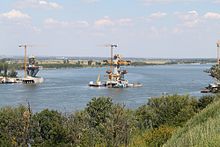- Vidin
-
Vidin
ВидинBaba Vida Castle 
Coat of armsLocation of Vidin Coordinates: 43°59′N 22°52′E / 43.983°N 22.867°ECoordinates: 43°59′N 22°52′E / 43.983°N 22.867°E Country Bulgaria Province
(Oblast)Vidin Government – Mayor Gergo Gergov Elevation 34 m (112 ft) Population (Census February 2011)[1] – City 47,138 – Urban 61,893 Time zone EET (UTC+2) – Summer (DST) EEST (UTC+3) Postal Code 3700 Area code(s) 094 Vidin (Bulgarian: Видин, archaically spelled as Widdin in English) is a port town on the southern bank of the Danube in northwestern Bulgaria. It is close to the borders with Serbia and Romania, and is also the administrative centre of Vidin Province, as well as of the Metropolitan of Vidin (since 870). As of February 2011, the town has a population of 47,138 inhabitants.[1]
An agricultural and trade centre, Vidin has a fertile hinterland renowned for its wines.
Contents
Geography
Vidin is the westernmost important Bulgarian Danube port and is situated on one of the southernmost sections of the river. A ferryboat complex, linking Vidin with Calafat on the opposite side of the river, is located 2 km from the town. The complex is to be replaced by the Vidin-Calafat Bridge probably in the year 2012.
Population
Vidin is the 19th town by population in Bulgaria, but serious demographic problems have been experienced in the area during the last two decades. The number of the residents of the city reached its peak in the period 1988-1991 when exceeded 65,000.[2] The following table presents the change of the population after the liberation of the country in 1878.
Vidin Year 1887 1910 1934 1946 1956 1965 1975 1985 1992 2001 2005 2009 2011 Population 14,772 16,450 18,465 18,481 23,932 36,981 53,179 62,541 62,666 57,395 52,558 49,471 47,138 Highest number 68,164 in 1991 Sources: National Statistical Institute,[1][2][3] „citypopulation.de“,[4] „pop-stat.mashke.org“,[5] Bulgarian Academy of Sciences[6] There are also some Vlachs (Romanians) who live in Vidin and to the north of it.
History
Vidin emerged at the place of an old Celtic settlement known as Dunonia. The name itself meant "fortified hill" with the typically Celtic dun found frequently in Celtic place names.[7] The settlement evolved into an Roman fortified town called Bononia. The town grew into one of the important centres of the province of Upper Moesia, encompassing the territory of modern northwestern Bulgaria and eastern Serbia. Roman rule lasted until 46 AD.
When Slavs settled in the area, they called the town Badin or Bdin, where the modern name comes from.
Vidin's main landmark, the Baba Vida fortress, was built in the period from the 10th to the 14th century. In the Middle Ages Vidin used to be an important Bulgarian city, a bishop seat and capital of a large province. Between 971 and 976 the town was the center of Samuil's possessions while his brothers ruled to the south. In 1003 Vidin was seized by Basil II after an eight month siege because of the betrayal of the local bishop. Its importance once again rose during the Second Bulgarian Empire (1185–1396) and its despots were influential figures in the Empire and were on several occasions chosen for Emperors. From the mid 13th century it was ruled by the Shishman family. In 1356, Bulgarian Tsar Ivan Alexander isolated Vidin from the Bulgarian monarchy and appointed his son Ivan Stratsimir (1356–1396) as absolute ruler of Vidin's new city-state - the Tsardom of Vidin (Bdin / Badin).
Hungarian occupation of Vidin
Main article: Hungarian occupation of VidinIn 1365, the Tsardom of Vidin was occupied by Magyar crusaders. Under Hungarian rule, the city became known as Bodony, but the occupation was short-lived. In 1369, a united Slavic Bulgarian empire drove out the Hungarian military, but in 1393 the whole of Bulgaria, along with the rest of the surrounding region, fell to the Ottoman Empire. This brought an end to Bulgaria's medieval state empire.
The Ottomans
The Ottomans went on to conquer the despotates of Dobrudzha, Prilep and Velbazhd as well. Vidin's independence did not last long. In 1396, Stratsimir contributed soldiers to assist the Slavic nations' bid to overturn the Ottoman Empire. Following defeat at the hands of the Ottomans outside the city of Nicopolis, Vidin finally fell under the sphere of the Ottomans, led by Bayezid I, as a punishment for their role in the hostilities.
In the late years of Ottoman rule, Vidin was the centre of Turkish rebel Osman Pazvantoğlu's breakaway state.
Modern rule
During the Serbo-Bulgarian War (1885), the town was besieged by a Serbian army. Although vastly outnumbered, the Bulgarians were victorious.
Tourism
Vidin boasts two well-preserved medieval fortresses, Baba Vida and Kaleto, as well as many old Orthodox churches such as St Pantaleimon, St Petka (both 17th century), and St Greatmartyr Dimitar (Dimitrius) (19th century), The Vidin Synagogue (1894), the Osman Pazvantoğlu mosque and library, the late 18th century Turkish ruler of northwestern Bulgaria, the Krastata Kazarma of 1798, and a number of old Renaissance buildings.
Another tourist attraction in the Vidin area is the town of Belogradchik, famous for its unique and impressive rock formations, the Belogradchik Rocks and the medieval Belogradchik Fortress and also the nearby Magura Cave with its beautiful prehistoric cave paintings.
Transportation
In Vidin is a Border-station to neighboring Romania via the Danube river. At the moment it is operated by ferryboats, crossing the river every 1/2 hour with only 5 trucks. Ticket price is EUR 50,-- per truck and EUR 12,-- per car. This border point is expected to increase it's attraction with the Danube Bridge 2. It is under construction at the moment and shall start operation in 2013.
Landmarks
Close to the town lies a powerful mediumwave broadcasting station (since 1973) whose signals can be easily received throughout Europe. It works on 576 kHz and on 1224 kHz with a power of 500 kW each. For transmission on 576 kHz a 259 metres tall guyed mast equipped with a cage antenna at its lower part is used. The transmission of 576 kHz Radio Hristo Botev is put on hold for now, because of the world financial crisis and it is unknown when it will resume broadcasting. Powerful FM transmitter on 88.2 MHz provides good coverage for Hristo Botev radio. Only 1224 kHz Radio Bulgaria remains atm. For the transmission on 1224 kHz 4 guyed masts, insulated against ground, which are each equipped with a cage antenna are used, which allows a switchable directional pattern.
Honour
Vidin Heights on Livingston Island in the South Shetland Islands, Antarctica is named after Vidin.
Gallery
-
A view of the Danube from Baba Vida
-
Elegant fin de siècle house
International relations
Twin towns — Sister cities
Vidin is twinned with:
 Hódmezővásárhely, Hungary [8]
Hódmezővásárhely, Hungary [8] West Carrollton, Ohio, USA [9]
West Carrollton, Ohio, USA [9] Zaječar, Serbia [10]
Zaječar, Serbia [10] Rivne, Ukraine [11]
Rivne, Ukraine [11] Demre, Turkey [12]
Demre, Turkey [12] Calafat, Romania [13]
Calafat, Romania [13]
Partner towns
References
- ^ a b c (Bulgarian)National Statistical Institute - Main Towns Census 2011
- ^ a b (Bulgarian)National Statistical Institute - Towns population 1956-1992
- ^ (English) Bulgarian National Statistical Institute - Bulgarian towns in 2009
- ^ (English) „WorldCityPopulation“
- ^ „pop-stat.mashke.org“
- ^ (Bulgarian) Bulgarian Academy of Sciences
- ^ Veyrenc, Charles Jacques (1981). Bulgaria Nagel's encyclopedia-guide (2 ed.). Nagel. pp. 413. ISBN 9782826305606. "In the 3rd century BC the Celts established on the site now occupied by Vidin a fortress to which they gave the name of Dunonia, "fortified hill""
- ^ http://www.vidin.bg/index.php?option=com_wrapper&view=wrapper&Itemid=334
- ^ http://www.vidin.bg/index.php?option=com_wrapper&view=wrapper&Itemid=336
- ^ http://www.vidin.bg/index.php?option=com_wrapper&view=wrapper&Itemid=337
- ^ http://www.vidin.bg/index.php?option=com_wrapper&view=wrapper&Itemid=339
- ^ http://www.vidin.bg/index.php?option=com_wrapper&view=wrapper&Itemid=340
- ^ http://www.vidin.bg/index.php?option=com_wrapper&view=wrapper&Itemid=341
- ^ http://www.vidin.bg/index.php?option=com_wrapper&view=wrapper&Itemid=342
- ^ http://www.vidin.bg/index.php?option=com_wrapper&view=wrapper&Itemid=344
- ^ http://www.vidin.bg/index.php?option=com_wrapper&view=wrapper&Itemid=345
- ^ http://www.vidin.bg/index.php?option=com_wrapper&view=wrapper&Itemid=346
External links
- The Information Web Portal of Vidin
- Pictures Of Baba Vida
- Old Pictures From Vidin
- Official website
- Vidin info
- Vidin article at Pictures of Bulgaria
- Vidin photo gallery
- All About Vidin
- Pictures of Vidin Broadcasting Station
Capital: VidinVillages Akatsievo, Antimovo, Bela Rada, Botevo, Bukovets, Voynitsa, Vartop, Gaytantsi, General Marinovo, Gomotartsi, Gradets, Dinkovitsa, Dolni Boshnyak, Drujba, Dunavtsi, Jeglitsa, Ivanovtsi, Inovo, Kalenik, Kapitanovtsi, Koshava, Kutovo, Mayor Uzunovo, Novoseltsi, Peshakovo, Plakuder, Pokrayna, Ruptsi, Sinagovtsi, Slana bara, Slanotrun, Turnyane, Tsar SimeonovoLandmarks Culture Notable people The Danube Countries 
Cities Tributaries Islands Categories:- Vidin
- Populated places on the Danube
- Populated places in Bulgaria
- Former capitals of Bulgaria
- Vidin Province
-
Wikimedia Foundation. 2010.















